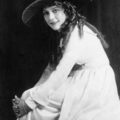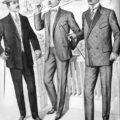1902 womens fashion – Artistic Viennese ideas
January 10, 2016On top of a richly embroidered patchwork floats a pale, disembodied face, maybe a shoulder or hand. This description could probably apply to any number of Gustav Klimt’s famous works. Actually completed in oil paint and gold leaf, Klimt’s works from about 1900 onwards show such an interest in the detail of glorious textiles that they could almost have been pieced out of silk and sequins.Here we look at 1902 womens fashion.
1902 womens fashion – Emilie Flöge
This 1902 work shows his friend and life companion, Emilie Flöge in a quite unusual example of 1902 womens fashion. “Life Companion” in this context doesn’t mean necessarily mean common law wife, mistress or girlfriend – we don’t know whether the pair ever had a sexual relationship but they were close friends, often photographed together. Equally, maybe they did – the unmarried Gustav Klimt was rumoured to have had up to seventeen affairs with different women and Emilie could have been one of them. Emilie, one of the prominent members of the Viennese Fin de Siecle artistic circles was also unmarried. Klimt painted her several times, and experts believe that his most famous painting, “The Kiss” of 1904, show the pair together as lovers
1902 womens fashion – artistic Viennese ideas
Vienna at the turn of the century was a hub of artistic ideas, and these two were right in the thick of it.
The story behind their friendship is a bit complicated. Emilie’s younger sister Helene married Gustav’s brother Ernst in 1891. But Ernst died soon after in 1892, and so Gustav became Helen’s guardian.This wasn’t unusual, and in fact, many brothers who had promised to look after their sibling’s wives if anything happened to them ended up by marrying them. But perhaps Gustav was more interested in Helene’s older sister.Emilie was only 18 years old then and still living with her parents, and Gustav, as Helene’s guardian, spent a lot of time at the parental home with the family, even going on holiday with them in the summer.
1902 womens fashion – Schwestern Flöge
Emilie started her career as a seamstress, but after winning a dressmaking competition in partnership with her elder sister Pauline her star rose, and in 1904 she opened a haute couture salon in one of Vienna’s chicest addresses. It was called Schwestern Flöge (Flöge Sisters).
The shop sold very well regarded but quite conventional dresses. Emilie, meanwhile dressed in a way that was anything but conventional. Her personal style encompassed long, flowing gowns, made without corsets and patterned with strong geometric or floral designs, sometimes both at once. These are the garments that Klimt’s sitters are often clothed in.
Gustav Klimt’s contribution
Gustav Klimt also drew some clothing designs for Schwestern Flöge, and was able to introduce her to his rich portrait clients, who became clients of her dress shop too. From as least as early in 1902 womens fashion It became one of the leading Viennese fashion businesses right up until the Second World War when it was forced to close as her clients lost their personal wealth and fashion and clothing became possibly the last things on their minds.
When Klimt died in 1918 he left her half of his estate, the other half going to his family.
Emilie Louise Flöge – 30 August 1874 – 26 May 1952
Gustav Klimt – July 14, 1862 – February 6, 1918







